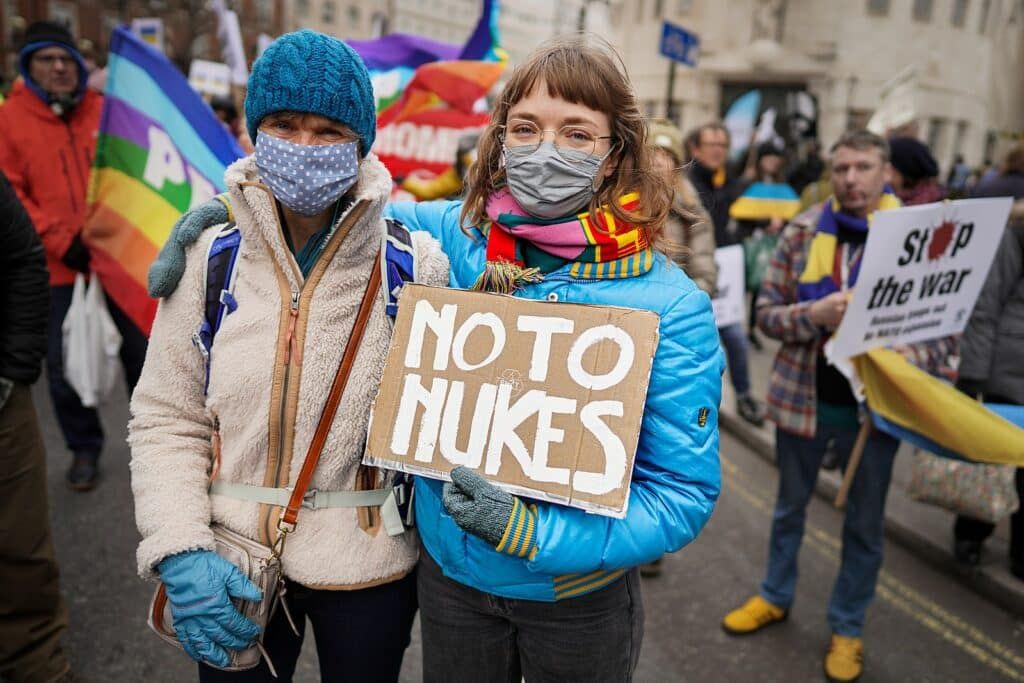Can women save the world?
By Elisabeth Eaves | June 15, 2017
 Photo credit: Alisdare Hickson (CC BY-SA 2.0).
Photo credit: Alisdare Hickson (CC BY-SA 2.0).
The heroine of the movie Wonder Woman, which is currently filling box office coffers with dollars and girls’ hearts with the joy of vicarious aggression, is trained to kill. In the film’s comic-book lore, loosely based on Greek myth, she is also a savior—programmed to kill, yes, but specifically to defeat Ares, the god of war, and thereby restore peace to mankind. She goes around saying things like, “We are the bridge to a greater understanding between all men.” She knows that Ares can’t be far away when she stumbles into the late stages of World War I and a German plot to unleash chemical weapons, which are in research and development under a petite mad scientist called Dr. Poison. Wonder Woman does what superheroes do, and—spoiler alert—peace ensues, at least until the sequel.
We don’t have to turn to fiction, though, to find women trying to save the world from weapons of mass destruction. In fact, the history of women-led peace movements is exceptionally rich. Why is that? The claim that women are somehow more peace-loving by their very nature strikes me as suspect, both because the idea of a female nature has been used to justify lesser legal status, and because history suggests that once in positions of power, female leaders are as hawkish as anyone else. It was British Prime Minister Margaret Thatcher, after all, who told US President George H.W. Bush that Saddam Hussein’s invasion of Kuwait was “no time to go wobbly.” But in a world where women lack parity across business and government, something turns a surprising number of them into peace leaders.
On Saturday June 17, a Women’s March to Ban the Bomb will take place outside United Nations headquarters in New York. To those who don’t follow nuclear weapons, this may sound anachronistic. Wasn’t marching against the atomic bomb something people did in the 1960s? Yes. In fact, in November 1961, about 50,000 women marched in 60 cities to demand an end to atomic testing. They included about 1,500 who demonstrated at the foot of the Washington Monument, led by Dagmar Wilson, founder of the group Women Strike for Peace. Two years later, the United States and Soviet Union signed a nuclear test ban treaty.
While large anti-Bomb street protests went away, though, nuclear weapons did not. They didn’t even fall into the kind of disrepute that surrounds chemical and biological weapons. The international community managed to ban both of those, as well as some of the nastier non-mass-destruction weapons, like land mines and cluster munitions. But there is no ban on nuclear weapons, which can kill vastly more non-combatants at a time. As Wonder Woman, a naif in the mysterious world of men, asks, “What kind of weapon kills innocents?”
Despite the continued existence of nuclear weapons, the voices against them grew quiet for a few decades. That’s partly because in 1970, the Nuclear Non-Proliferation Treaty went into effect. Under it, the world agreed that it was OK for China, France, the United Kingdom, the United States, and the USSR to keep their nuclear weapons, as long as they promised not to acquire any more and to slowly get rid of what they had. They did downsize for a while—the United States and Russia, which together possessed the bulk of nuclear weapons, radically cut the size of their arsenals between 1986 and the early teens.
In the early 1990s, the Soviet Union broke apart and the Cold War ended, making people worry even less about nuclear war. But then disarmament slowed down. There may be fewer nuclear weapons in the world now than there were at the height of the Cold War, but “fewer” is a meaningless concept when there are still enough—just under 10,000—to destroy everyone and everything on the planet several times over. Also, more countries have nuclear weapons now, with Israel, India, Pakistan, and North Korea in on the game, and still more have attempted to develop them. Meanwhile the two nuclear heavyweights, while in the strictest sense not building “new” nuclear weapons, have embarked on multi-billion dollar efforts to upgrade and modernize the ones they have.
Which brings us to the new effort to ban the Bomb. In recent years a lot of smaller, non-nuclear armed countries got fed up with the status quo. Their citizens would be just as dead as everyone else in a major nuclear war, they pointed out, and decided to do something about the risk. UN talks on a ban treaty began in March and resumed on June 15, with the nuclear-armed countries, to no one’s surprise, boycotting the proceedings. A ban of some kind will likely be born; what its effect will be, given the disinterest of the nuclear powers and the lack of enforcement means, is up for debate.
Women are among the leaders of this new peace movement. Saturday’s Women’s March to Ban the Bomb is open to all genders, but organized by a group called the Women’s International League for Peace and Freedom, which has a distinguished resume. It was founded during World War I to, in its words, “make known and eliminate the causes of war.” Two of the organization’s leaders, Jane Addams and Emily Greene Balch, won Nobel Peace Prizes.
The idea that women might have the power to demand peace long pre-dates anything like women’s rights in the modern sense. In the fifth century BC, the playwright Aristophanes staged the comedy Lysistrata, in which the title character tries to persuade the other women of Greece to withhold sex from their menfolk as a means of forcing an end to the Peloponnesian War.
Modern times have also produced women-led peace movements. American Catholic nuns have a history of non-violently protesting nuclear weapons, as Eric Schlosser detailed in the New Yorker in 2015. Two women, Betty Williams and Mairead Corrigan, launched the Northern Ireland Peace Movement, for which they were awarded the Nobel Peace prize in 1976. The Mothers of the Plaza de Mayo, marching to demand justice for their children murdered by Argentina’s military government, led the effort to ensure the perpetrators were prosecuted. And after years of devastating civil war, the Liberian peace movement led by Leymah Gbowee, which included a Lysistrata-style sex strike, helped topple the dictator Charles Taylor; she won the 2011 Nobel Peace Prize for her efforts. Israeli women launched the organization Women Wage Peace in the wake of the 2014 war in Gaza. It now claims 20,000 members from across the political spectrum, both Jewish and Arab, and says “we will not stop until there’s a political peaceful agreement to the conflict.”
As some would have it, women are simply more peace-prone than men. Political Scientist Valerie M. Hudson wrote in Foreign Policy, “we…know through experimental studies that post-conflict agreements that are negotiated without women break down faster than those that do include women, and that all-male groups take riskier, more aggressive, and less empathetic decisions than mixed groups—two phenomena that may lead to higher levels of interstate conflict.” Writing with co-authors in the book Sex and World Peace, Hudson also suggests, citing empirical evidence, that women are more risk averse and less corrupt.
Even if this is all true on average, though—and ignoring the thorny question of nature versus nurture—averages say nothing about qualities possessed by individuals, and women who rise to the top of international politics do not appear to be exceptionally peaceable. They do seem to have learned to couch their justifications for war in socially acceptable terms. In March, when American UN Ambassador Nikki Haley stepped before a microphone to defend her country’s need to possess a nuclear arsenal, she said, “As a mom, as a daughter, there is nothing I want more for my family then a world with no nuclear weapons, but we have to be realistic.” She made me think of Jodie Foster’s character in the sci-fi movie Elysium. Delacourt is the defense minister of an idyllic space station, to which the rich and lucky of Earth have absconded to get away from the hellscape they created down below. Delacourt’s aggressive bonafides are established when she orders several shuttles full of illegal immigrants, trying to get to the Eden she protects, shot down. Called before a sort of galactic Congressional panel to defend her harsh tactics, she says, “I’m a patriot. I’m the one protecting our children from the great unwashed.” Message: Advocating great violence to other humans is unseemly, but advocating great violence to other humans as a mother is totally okay.
Men are not above invoking this female prerogative. The US president’s son Eric Trump told a British newspaper that his sister Ivanka Trump, “a mother of three kids” who was “heartbroken and outraged” by the Syrian regime’s chemical weapons attack on civilians, influenced her father to respond. He did so by launching 59 cruise missiles at a Syrian government air base.
But if it’s not some part of their fundamental nature, why are there so many women peace leaders?
Perhaps it’s because women are disenfranchised in greater numbers and more ways than men. They are more often outsiders to the corridors of power. Women who have led peace movements have done so after finding themselves voiceless—unconsulted as to whether war goals were worth the risks taken. With less access to traditional political machinery and money and patronage, leading from the street, or the Internet, is a logical choice. To be sure, in many Western democracies, women are not outsiders to the extent they once were, but the legacy of seizing the reins when state and society have failed in their duty to protect survives as a tradition.
The new movement to ban the bomb is, likewise, about the previously voiceless speaking up. The fact that random innocent civilians all over the world are at risk of dying in a nuclear conflagration is a clear-cut failure. Having noted that the world’s nuclear-armed governments aren’t correcting the problem with much urgency, the voiceless have found a voice. Disgusted by a group of men waffling ineffectively about an armistice, Wonder Woman exclaims, “I’m the men who can.” The women marching to ban the Bomb are the men who can defeat our real-life Dr. Poisons.
Together, we make the world safer.
The Bulletin elevates expert voices above the noise. But as an independent nonprofit organization, our operations depend on the support of readers like you. Help us continue to deliver quality journalism that holds leaders accountable. Your support of our work at any level is important. In return, we promise our coverage will be understandable, influential, vigilant, solution-oriented, and fair-minded. Together we can make a difference.
Topics: Nuclear Weapons, Opinion














